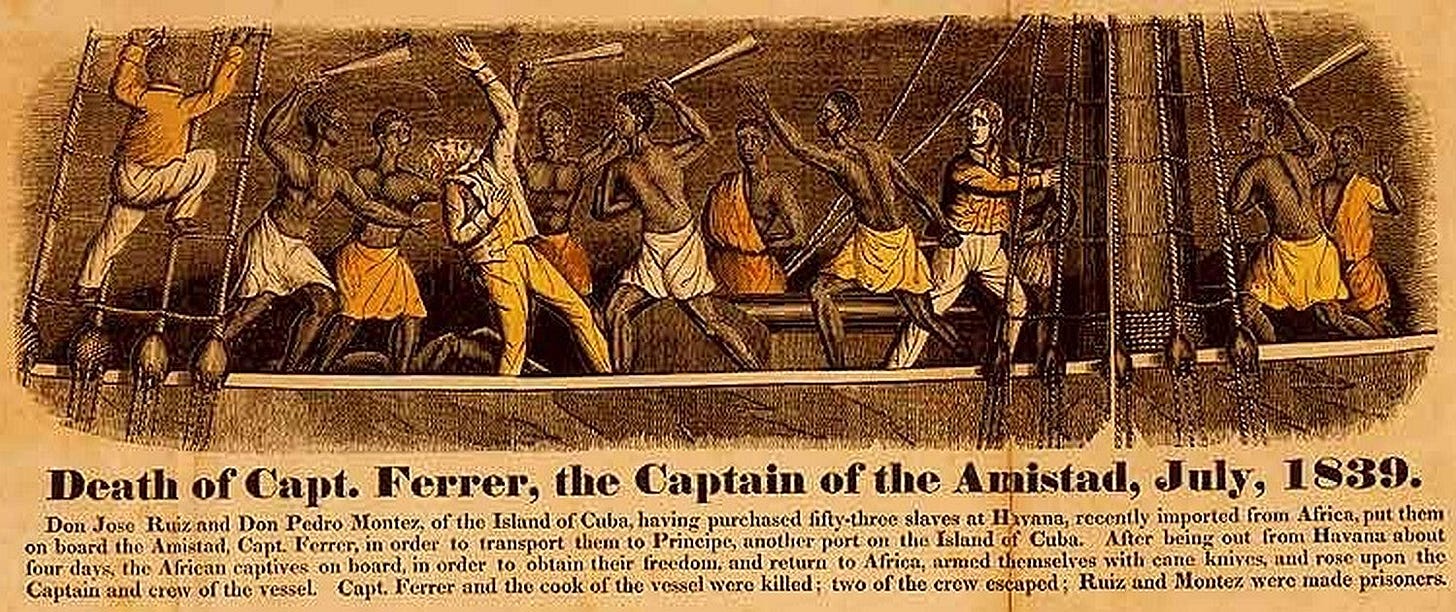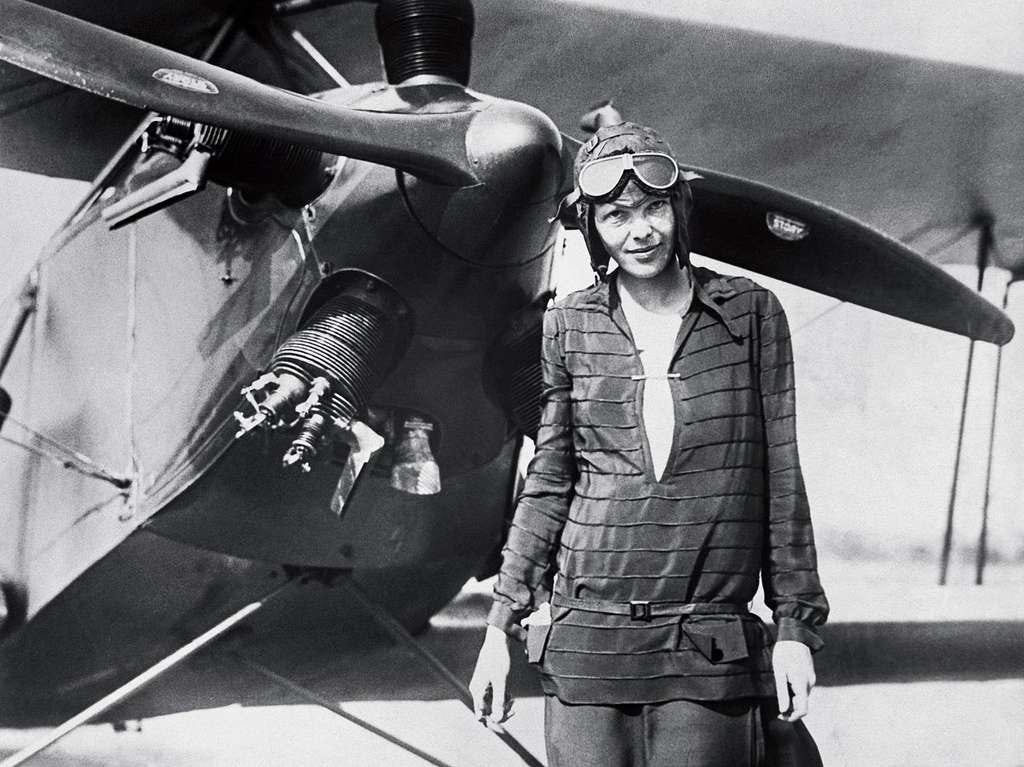The Mysteries of History (July 2 Edition)
Amistad Revolt; President Garfield Shot and Killed; Amelia Earhart Disappears; LBJ Signs the Civil Rights Act
1839 — Revolt on the Amistad
public domain image from wikimedia commons
It was on this date in 1839, twenty-two years before the beginning of the America Civil War, that a group of kidnapped Africans aboard the slave ship Amistad, knowing they were otherwise headed for a lifetime of bondage, rose up and steeled themselves to do what it took to “steal themselves.”
Led by a man named Sengbe Pieh, who was also known as Cinque, the mutineers took over the ship. As they were bound for sugarcane fields on Cuba, there were knives on board the vessel, which they located and used against the slavers, killing the captain and at least one other crew member (the fate of two of them is unclear, as they may have been thrown overboard or they may have escaped). Others of the crew were taken captive, in a “turnabout is fair play” scenario.
The “mutineers” had their captives sail them back towards Africa, which is the direction they headed while they were being watched, but when they could they head the opposite direction, toward America.
The Amistad was eventually found by an American ship and escorted to Connecticut. The Cuban slavers were freed by the Americans and demanded that “their” slaves be returned to them, saying they were Cuban-born (they were actually from Africa). Spain demanded the mutineers be returned to them to stand trial for piracy and murder.
The case ended up in an American court, though, and the decision was that the men who revolted against their kidnapping had been illegally enslaved, and they were to be returned to Africa.
Former President John Quincy Adams (1767-1848, in office 1825-1829) was on the successful defense team. President Martin Van Buren (1782-1862, in office 1837-1841) appealed the decision — twice — and lost both times. By November the kidnapped Africans were able to return to their homeland.
Questions: Have you seen the movie Amistad? What was Martin Van Buren’s first language?
1881 — President Garfield Shot
public domain image from wikimedia commons
When a new President takes office, he has a lot of jobs to dole out to people. One disappointed office seeker was put off enough by his rejection that, four months into James Garfield’s Presidency, on this date in 1881, he shot Garfield at a railroad station.
Garfield survived for almost three months. His assailant was hanged a year after the murder, in June of 1882.
The following is what I wrote about James Garfield being shot in my book Still Casting Shadows: A Shared Mosaic of U.S. History — Volume 1: 1620-1913:
President James Abram Garfield was shot in Washington on the 2nd of July by Charles Guiteau, a sore-loser lawyer who was upset because his application to become the U.S. ambassador to France had been rejected by the President. Garfield lingered until September 19th, when he died from blood poisoning, a result of the bullet fired into him by the dis appointed barrister. Chester Arthur then took over the office of President, serving out Garfield’s term.
Questions: Was there any U.S. President whose term in office was shorter than Garfield’s?
1937 — Amelia Earhart and Her Navigator Go Missing
public domain image from wikimedia commons
On this date in 1937, famed aviatrix Amelia Earhart (1897-1937) disappeared while on a planned ‘round-the-world flight with navigator Frederick Noonan (1893-1937).
They nor their Lockheed Electra aircraft have ever been found. The last contact with Earhart was that they were lost and running low on fuel, somewhere between New Guinea and Howland Island in the Pacific Ocean.
Earhart and Noonan had already completed three quarters (22,000 miles) of the trip; had they been able to reach Howland Island, their next stops would have been Hawaii and then back to California, their starting point.
The pair had attempted the 29,000 mile equatorial flight earlier in the year, going the opposite direction (flying west to east that first time), and were to be on their way from Hawaii to Howland Island when they had a mishap on the runway at Honolulu which postponed the trip. So in both cases their trip ended with Howland Island as their next waypoint.
It is likely that Earhart ditched the plane in the Ocean, and it’s possible that she and Noonan survived the crash-landing and were able to board a life raft, but again, they were never found, so how exactly their lives ended remains unknown.
Questions: Have you ever flown (as a passenger) in a small plane? If not, would you like to? Have you ever flown (piloted) an aircraft? If not, would you like to? Do you think it will ever be known what exactly happened to Earhart and Noonan?
1964 — LBJ Signs Civil Rights Act
public domain image from wikimedia commons
Ten years after the Supreme Court had decided that school segregation was unconstitutional, LBJ (Lyndon Baines Johnson) signed the Civil Rights Act of 1964. Between those events occurred the bus boycott in Montgomery, Alabama, following Rosa Parks’ refusal to give up her seat on a bus there in 1955 and Martin Luther King Jr’s “I Have a Dream” speech before a very large crowd in Washington, D.C. in 1965.
JFK (John Fitzgerald Kennedy) had been pursuing passing Civil Rights legislation, but was murdered before that was accomplished. Vice President LBJ then became President, and shepherded it through.
Besides outlawing segregation in public places (such as buses [think Rosa Parks, et al], parks, schools [think Brown v Board of Education, 1954, alluded to above], and swimming pools), the new laws prohibited discrimination in employment or education.
The following is what I wrote about the signing of the Civil Rights Act in 1964 in my book Still Casting Shadows: A Shared Mosaic of U.S. History — Volume 2: 1914-2006:
“This ‘Wait’ has almost always meant ‘Never.’ It has been a tranquilizing thalidomide, relieving the emotional stress for a moment, only to give birth to an ill-formed infant of frustration…”—Martin Luther King, Jr
Before he was killed, John F. Kennedy had promised to pass Civil Rights legislation. His successor, Lyndon Johnson, followed through by shepherding the bill himself—Johnson said that was the best way to honor Kennedy’s memory.
At this point, many in the Civil Rights movement thought their goals had been achieved and their work was done. The other side intensified their efforts, though: the Ku Klux Klan and their sympathizers stepped up beatings, shootings, and bombings in the South, particularly in Mississippi, the deepest of the deep South states.
Like the Indians before them, and the environmental groups after them, the various Civil Rights Groups, such as SNCC (Student Nonviolent Coordinating Committee), SCLC (Southern Christian Leadership Conference), CORE(Congress of Racial Equality), SDS (Students for a Democratic Society), etc., never seemed able to coalesce and cooperate. Thus, rather than being synergetic, they dissipated much of their potential combined energy and power by fragmenting into fractious factions. Infighting, egos, and ambitions—as tends also to happen in popular musical groups, sports teams, and the halls of government—sunk a lot of their ships and dammed them to gradual disintegration. Fighting for integration in society at large, they—for the most part—failed to integrate within their own like-purposed groups.
Many members of the SNCC, in fact, ultimately rejected the “N” (Non violent) part of their name. Some also spun a 180 as regards their views on racial integration. Whereas integration had formerly been their goal, they now espoused segregation themselves, wanting nothing to do with a biracial society. Indeed, there came a time when whites, who had been members and in many cases held responsible positions in the organization, were no longer welcome in SNCC. Thus, they self-destructed and were, in effect, “conquered” by white racists by becoming just like them.
Questions: How many of the people in the picture above can you identify? Are any of them still living? Are Civil Rights still improving, or has there been a regression in the application of fair and equal treatment for all?









